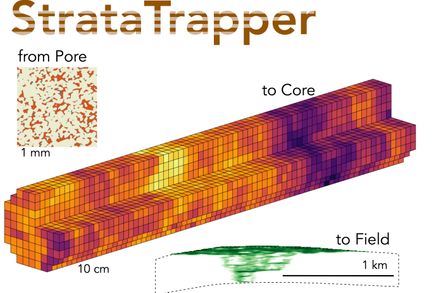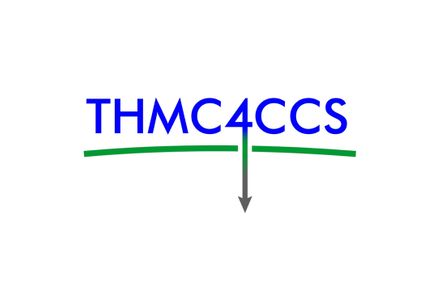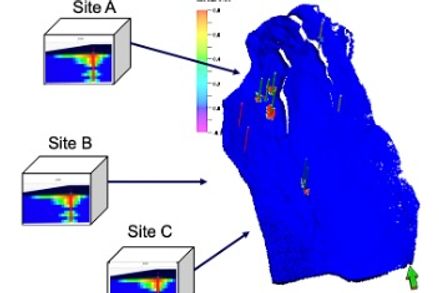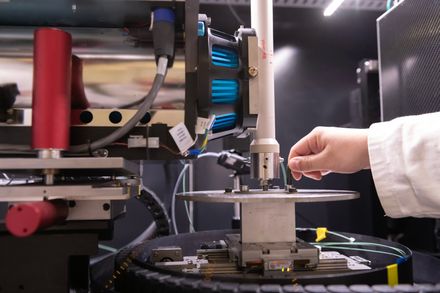We investigate the physics, chemistry, and techno-economics of CO2 storage underground
Our research includes exploring fundamental pore scale fluid dynamics, developing digital rocks analysis techniques, increasing the accuracy of field scale reservoir simulation, and evaluating the feasibility of scaling up CO2 storage to climate relevant scales.
Our Research Projects

StrataTrapper Advanced Modelling of CO2 Migration and Trapping

THMC4CCS: ThorougH experiMental and numerical investigation of Coupled processes for geologiC Carbon Storage
Results
- Showing results for:
- Reset all filters
Search results
-
Conference paperAgada S, Kolster C, Williams G, et al., 2016,
Modelling basin-scale CO2 storage in the Bunter Sandstone of the UK Southern North Sea
In this paper, a reservoir simulation model of the large-scale Bunter Sandstone in the UK Southern North Sea is used to evaluate the dynamics of regional CO2 plume transport and storage. We have tested the sensitivity of injection capacity to a range of target CO2 injection rates and the number of sites at which injection is deployed. In addition to geology, the model is constrained by local bottom-hole-pressure (BHP) limits and site spacing. Large-scale pressure buildup limitations and the impact of brine production on storage capacity are also evaluated. Furthermore, monitoring of the CO2 plume at multiple injection sites indicates important subsurface controls on plume migration in the context of short-term (approx. 50 years) and long-term CO2 storage (approx. 1000 years).
-
Conference paperDjabbarov S, Jones ADW, Krevor S, et al., 2016,
Experimental and numerical studies of first contact miscible injection in a quarter five spot pattern
We quantify the impact of mobility, simple heterogeneities and grid orientation error on the performance of first contact miscible gas flooding in a quarter five spot configuration by comparing the outputs from experimental and numerical models. The aim is to quantify the errors that may arise during simulation and to identify a workflow for minimizing these when conducting field scale fingering studies. A commercial reservoir simulator was validated by comparing its predictions with the results obtained from physical experiments. An uncorrelated, random permeability distribution was used to trigger fingering in the simulations. The physical experiments were carried out using a Hele-Shaw cell (40x40cm) designed and constructed for this study. The impact of a square low permeability inclusion (20x20cm) on flow was investigated by varying its permeability, location and orientation. For lower mobility ratios (M=2 to M=10) the commercial numerical simulator was able to reproduce the experimental observations within the uncertainty range of the permeability distribution used to trigger the fingers, provided a nine-point scheme was used for the pressure solution. At higher mobility ratios (M=20 to M=100) the grid orientation effect meant that the simulator overestimated the areal sweep even when a nine-point scheme was used. The introduction of a square, low permeability inclusion near the injection well reduced the discrepancy between experimental and numerical results, bringing it back within uncertainty limits in some of the cases. This was mainly because the real flow was then forced to move parallel to the edges of the Hele-Shaw cell and thus parallel to the simulation grid. Breakthrough times were well predicted by the numerical simulator at all mobility ratios.
-
Conference paperLi X, Yi T, Giddins M, et al., 2016,
A novel approach for waterflood management optimisation using streamline technology
This paper presents a new streamline-based workflow to cover the two main aspects of waterflood management optimisation: infill drilling well location identification and injection rate allocation. Streamline properties are used in every step of the evaluation and decision-making process in the workflow. A novel ranking scheme, weighted by streamline 'remaining mobile oil in pattern', is developed in this study. The well ranking criteria are not only based on the properties of individual well completion cells as in a traditional quality map, but also account for connectivity between injector/producer pairs. In such a way, candidate producers at high-quality map locations, but with poor connectivity or limited swept area, can be screened out. The other main component of the workflow is to perform dynamic pattern injection reallocation in response to the changed well pattern resulting from newly introduced producers. A unique insight for utilization of a multi-zone waterflood for a vertically heterogeneous field is also provided. 2D and 3D heterogeneous models were used to develop and validate the workflow for its general implementation on real field models. The final oil recovery and net present value (NPV) analysis show that the oil recovery can be increased significantly compared to traditional optimisation methods.
-
Journal articleOostrom M, White MD, Porse SL, et al., 2015,
Comparison of relative permeability-saturation-capillary pressure models for simulation of reservoir CO2 injection
, International Journal of Greenhouse Gas Control, Vol: 45, Pages: 70-85, ISSN: 1750-5836Constitutive relations between relative permeability (kr), fluid saturation (S), and capillary pressure (Pc) determine to a large extent the distribution of brine and supercritical CO2 (scCO2) during subsurface injection operations. Published numerical multiphase simulations for brine-scCO2 systems so far have primarily used four kr-S-Pc models. For the S-Pc relations, either the Brooks-Corey (BC) or Van Genuchten (VG) equations are used. The kr-S relations are based on Mualem, Burdine, or Corey equations without the consideration of experimental data. Recently, two additional models have been proposed where the kr-S relations are obtained by fitting to experimental data using either an endpoint power law or a modified Corey approach. The six models were tested using data from four well-characterized sandstones (Berea, Paaratte, Tuscaloosa, Mt. Simon) for two radial injection test cases. The results show a large variation in plume extent and saturation distribution for each of the sandstones, depending on the used model. The VG-Mualem model predicts plumes that are considerably larger than for the other models due to the overestimation of the gas relative permeability. The predicted plume sizes are the smallest for the VG-Corey model due to the underestimation of the aqueous phase relative permeability. Of the four models that do not use fits to experimental relative permeability data, the hybrid model with Mualem aqueous phase and Corey gas phase relative permeabilities provide the best fits to the experimental data and produce results close to the model with fits to the capillary pressure and relative permeability data. The model with the endpoint power law resulted in very low, uniform gas saturations outside the dry-out zone for the Tuscaloosa sandstone, as the result of a rapidly declining aqueous phase relative permeability. This observed behavior illustrates the need to obtain reliable relative permeability relations for a potential reservoir, beyond permeabi
-
Journal articleReynolds C, Krevor S, 2015,
Characterising flow behaviour for gas injection: relative permeability of CO sub 2 /sub -brine and N sub 2 /sub-water in heterogeneous rocks
, Water Resources Research, Vol: 51, Pages: 9464-9489, ISSN: 0043-1397We provide a comprehensive experimental study of steady state, drainage relative permeability curves with CO2-brine and N2-deionized water, on a single Bentheimer sandstone core with a simple two-layer heterogeneity. We demonstrate that, if measured in the viscous limit, relative permeability is invariant with changing reservoir conditions, and is consistent with the continuum-scale multiphase flow theory for water wet systems. Furthermore, we show that under capillary limited conditions, the CO2-brine system is very sensitive to heterogeneity in capillary pressure, and by performing core floods under capillary limited conditions, we produce effective relative permeability curves that are flow rate and fluid parameter dependent. We suggest that the major uncertainty in past observations of CO2-brine relative permeability curves is due to the interaction of CO2 flow with pore space heterogeneity under capillary limited conditions and is not due to the effects of changing reservoir conditions. We show that the appropriate conditions for measuring intrinsic or effective relative permeability curves can be selected simply by scaling the driving force for flow by a quantification of capillary heterogeneity. Measuring one or two effective curves on a core with capillary heterogeneity that is representative of the reservoir will be sufficient for reservoir simulation.
-
Journal articleAl-Menhali A, Niu B, Krevor S, 2015,
Capillarity and wetting of carbon dioxide and brine during drainage in Berea sandstone at reservoir conditions
, Water Resources Research, Vol: 51, Pages: 7895-7914, ISSN: 0043-1397The wettability of CO2-brine-rock systems will have a major impact on the management of carbon sequestration in subsurface geological formations. Recent contact angle measurement studies have reported sensitivity in wetting behaviour of this system to pressure, temperature and brine salinity. We report observations of the impact of reservoir conditions on the capillary pressure characteristic curve and and relative permeability of a single Berea sandstone during drainage - CO2 displacing brine - through effects on the wetting state. Eight reservoir condition drainage capillary pressure characteristic curves were measured using CO2 and brine in a single fired Berea sandstone at pressures (5 to 20 MPa), temperatures (25 to 50°C) and ionic strengths (0 to 5 mol kg−1 NaCl). A ninth measurement using a N2-water system provided a benchmark for capillarity with a strongly water wet system. The capillary pressure curves from each of the tests were found to be similar to the N2-water curve when scaled by the interfacial tension. Reservoir conditions were not found to have a significant impact on the capillary strength of the CO2-brine system during drainage through a variation in the wetting state. Two steady-state relative permeability measurements with CO2 and brine and one with N2 and brine similarly show little variation between conditions, consistent with the observation that the CO2-brine-sandstone system is water wetting and multiphase flow properties invariant across a wide range of reservoir conditions.
-
Journal articleLai P, Moulton K, Krevor S, 2015,
Pore-scale heterogeneity in the mineral distribution and reactive surface area of porous rocks
, Chemical Geology, Vol: 411, Pages: 260-273, ISSN: 0009-2541The reactive surface area is an important control on interfacial processes between minerals and aqueous fluids in porous rocks. Spatial heterogeneity in the surface area can lead to complications in modelling reactive transport processes, but quantitative characterisation of this property has been limited. In this paper 3D images obtained using x-ray micro-tomography were used to characterise heterogeneity in surface area in one sandstone and five carbonate rocks. Measurements of average surface area from x-ray imagery were 1-2 orders of magnitude lower than measurements from nitrogen BET. A roughness factor, defined as the ratio of BET surface area to x-ray based surface area, was correlated to the presence of clay or microporosity. Co-registered images of Berea sandstone from x-ray and energy dispersive spectroscopy imagery were used to guide the identification of quartz, K-feldspar, dolomite, calcite and clays in x-ray images. In Berea sandstone, clay and K-feldspar had higheraverage surface area fractions than their volumetric fractions in the rock. In the Edwards carbonate, however, modal mineral composition correlated with surface area. By sub-sampling digital images, statistical distributions of the surface area were generated at various length scales of subsampling. Comparing these to distributions used in published modelling studies showed that the common practice of leaving surface area and pore volume uncorrelated in a pore has lead to unrealistic combinations of surface area and pore volume in the models. We suggest these models adopt a moderate correlation based on observations. In Berea sandstone, constraining ratios of surface area to pore volume to a range of values between that of quartz-lined and five times that of clay-lined spheres appeared sufficient.
-
Journal articleKrevor SC, Blunt MJ, Benson SM, et al., 2015,
Capillary trapping for geologic carbon dioxide storage - From pore scale physics to field scale implications
, International Journal of Greenhouse Gas Control, Vol: 40, Pages: 221-237, ISSN: 1750-5836A significant amount of theoretical, numerical and observational work has been published focused on various aspects of capillary trapping in CO2 storage since the IPCC Special Report on Carbon Dioxide Capture and Storage (2005). This research has placed capillary trapping in a central role in nearly every aspect of the geologic storage of CO2. Capillary, or residual, trapping – where CO2 is rendered immobile in the pore space as disconnected ganglia, surrounded by brine in a storage aquifer – is controlled by fluid and interfacial physics at the size scale of rock pores. These processes have been observed at the pore scale in situ using X-ray microtomography at reservoir conditions. A large database of conventional centimetre core scale observations for flow modelling are now available for a range of rock types and reservoir conditions. These along with the pore scale observations confirm that trapped saturations will be at least 10% and more typically 30% of the pore volume of the rock, stable against subsequent displacement by brine and characteristic of water-wet systems. Capillary trapping is pervasive over the extent of a migrating CO2 plume and both theoretical and numerical investigations have demonstrated the first order impacts of capillary trapping on plume migration, immobilisation and CO2 storage security. Engineering strategies to maximise capillary trapping have been proposed that make use of injection schemes that maximise sweep or enhance imbibition. National assessments of CO2 storage capacity now incorporate modelling of residual trapping where it can account for up to 95% of the storage resource. Field scale observations of capillary trapping have confirmed the formation and stability of residually trapped CO2 at masses up to 10,000 tons and over time scales of years. Significant outstanding uncertainties include the impact of heterogeneity on capillary immobilisation and capillary trapping in mixed-wet systems. Overall capillary trapp
-
Journal articleNiu B, Al-Menhali A, Krevor SC, 2015,
The impact of reservoir conditions on the residual trapping of carbon dioxide in Berea sandstone
, WATER RESOURCES RESEARCH, Vol: 51, Pages: 2009-2029, ISSN: 0043-1397- Author Web Link
- Open Access Link
- Cite
- Citations: 68
-
Conference paperZhou Z, Krevor S, Reynolds C, 2015,
A simulation investigation into the influence of thermophysical fluid properties on CO<inf>2</inf> brine core flooding experiments
, Pages: 1141-1157We used conventional numerical simulation of immiscible multiphase flow to reproduce laboratory observations of the CO2/Brine system. A model of homogeneous rock properties was QC'ed on Buckley-Leverett, gravity effect and capillary end effect. The natural rock heterogeneity in the core was modelled by capillary heterogeneity, and calibrated by fluid distribution observed during the experiment. The calibrated model was then used to produce synthetic relative permeability observables by changing thermophysical fluid properties, knowing what the intrinsic relative permeabilities are. It was discovered that a change in reservoir conditions and particularly CO2 viscosity can lead to changing the impact that a natural rock heterogeneity in the core has on the fluid distribution. We showed that viscous-pressuredrive determines the extent to which rock heterogeneity matters in a core flooding experiment and demonstrated that heterogeneity can lead to a deviation in observed relative permeability from its intrinsic value. Given CO2 viscosity changes much more dramatically with reservoir conditions than other fluids, the impact of reservoir conditions on relative permeability tests is apparently observed because the changing conditions increases or decreases the role of heterogeneity in the core. We therefore concluded that appropriate relative permeability observations require a homogeneous fluid distribution and thus flow rates should be used where possible to minimize the impact of heterogeneity.
This data is extracted from the Web of Science and reproduced under a licence from Thomson Reuters. You may not copy or re-distribute this data in whole or in part without the written consent of the Science business of Thomson Reuters.



